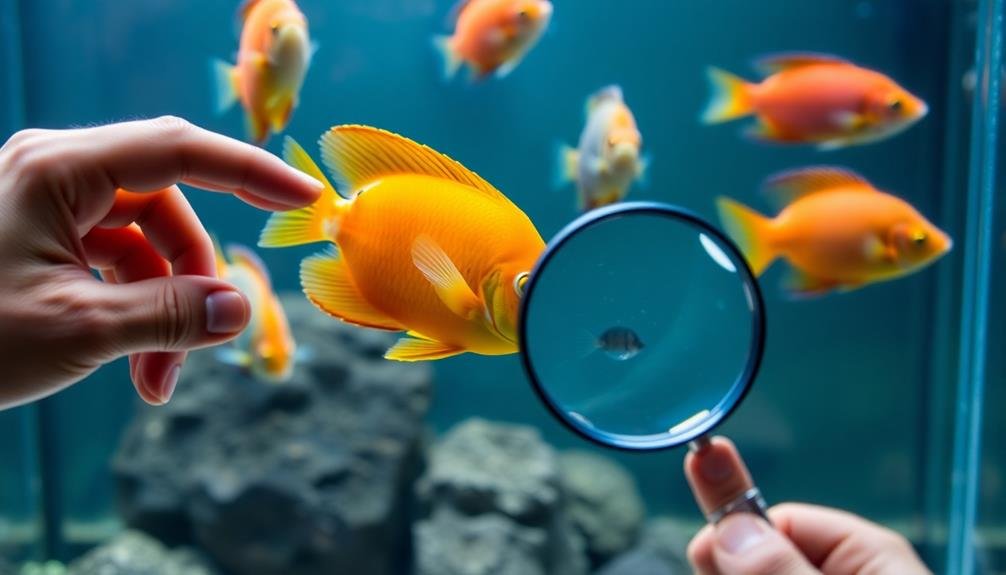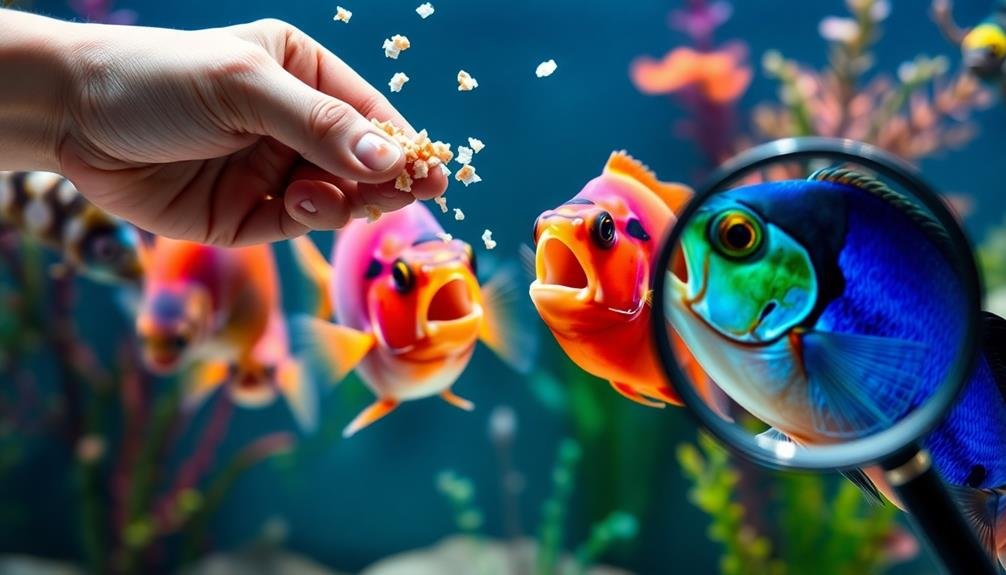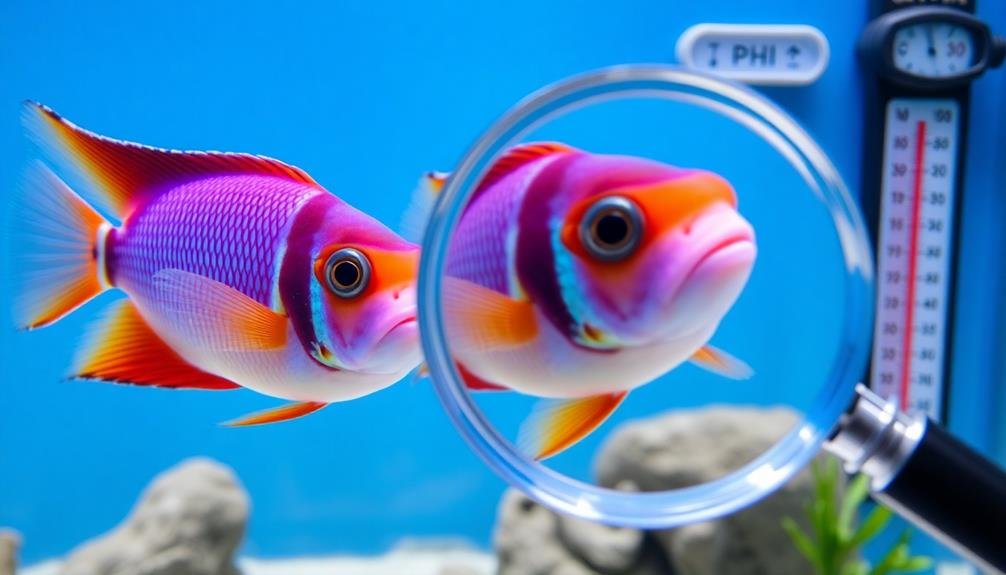Regular health checks are essential for your aquarium's well-being. Start with a visual inspection of fish behavior, looking for any unusual swimming patterns or signs of distress. Test water parameters weekly to guarantee ideal conditions. Observe your fish's appetite and feeding habits, as changes can indicate health issues. Examine gills and fins closely for signs of disease or parasites. Analyze body shape and color changes, which may signal underlying problems. Pay attention to swimming patterns, noting any erratic movements. Finally, monitor waste production for consistency in color and form. These simple checks will help you catch potential problems early and maintain a thriving aquatic environment.
Visual Inspection of Fish Behavior

When you approach your aquarium, take a moment to observe your fish closely. Their behavior can tell you a lot about their health. Look for signs of normal swimming patterns and activity levels. Healthy fish should move smoothly through the water, maintaining their balance without difficulty.
Pay attention to any fish that appear lethargic or are hiding more than usual. These could be early indicators of stress or illness. Watch for fish gasping at the surface, as this may signal poor water quality or respiratory issues. Erratic swimming, rubbing against objects, or scratching on gravel can indicate parasites or skin irritations.
Observe your fish during feeding time. Healthy fish are usually keen to eat and should respond quickly to food. If you notice any fish consistently refusing to eat or spitting out food, it might be a sign of digestive problems or other health issues.
Look for physical abnormalities such as swollen eyes, protruding scales, or unusual growths. Also, check for changes in coloration, as fading or darkening can sometimes indicate stress or disease.
Water Parameter Testing
While visual inspection is important, it's only part of maintaining a healthy aquarium. Regular water parameter testing is essential for ensuring your fish's well-being. You'll need to check key factors like pH, ammonia, nitrite, nitrate, and temperature.
Start by investing in a reliable test kit. You can find detailed kits that measure multiple parameters or individual tests for specific elements. Test your water at least once a week, or more frequently if you notice any changes in fish behavior.
pH levels should typically remain between 6.5 and 8.0, depending on your fish species. Ammonia and nitrite should always be at 0 ppm, while nitrate should stay below 20 ppm. Keep your aquarium temperature consistent, usually between 75-80°F for tropical fish.
If you detect any abnormalities, take immediate action. Perform partial water changes, adjust your filtration system, or use appropriate water treatments to correct imbalances.
Appetite and Feeding Assessment

You'll want to observe your fish's normal eating patterns closely to establish a baseline for their appetite.
Watch for their typical food acceptance behaviors, such as enthusiasm to eat when food is introduced or how quickly they consume their meals.
If you notice any sudden changes in these patterns, it could be an early indicator of health issues that require attention.
Normal Eating Patterns
A fish's appetite can reveal volumes about its health. Understanding normal eating patterns for your aquatic pets is vital for early detection of potential issues. Most healthy fish enthusiastically approach food when it's offered and consume it quickly. They should exhibit interest in feeding time and actively pursue their meals.
Different species have varying feeding habits, so it's important to research your specific fish. Some are grazers, constantly nibbling throughout the day, while others prefer scheduled feedings. Generally, you should feed your fish small amounts two to three times daily, offering only what they can consume within a few minutes.
Watch for consistent eating behaviors. If a typically voracious eater suddenly becomes disinterested in food, it could signal a problem. Conversely, if a fish that usually eats moderately starts frantically consuming everything in sight, it might indicate internal parasites or other health issues.
Pay attention to how your fish interact during feeding time. Dominant fish may eat more aggressively, while shy or stressed fish might hang back. Ensuring all fish have access to food is vital for maintaining overall tank health.
Food Acceptance Behaviors
Building on our understanding of normal eating patterns, let's explore specific food acceptance behaviors that can help you assess your fish's appetite and overall health.
Watch for enthusiastic responses when you approach the tank with food. Healthy fish often swim to the surface or front of the tank in anticipation. They should show interest in food and actively pursue it.
Observe how quickly your fish consume their meals. Most species will eat within a few minutes of food being introduced.
Pay attention to your fish's food preferences. While they might've favorites, they shouldn't completely refuse certain foods appropriate for their species. Be wary of fish that suddenly reject foods they previously enjoyed, as this can indicate health issues.
Notice how your fish interact with food particles. They should be able to locate and capture food efficiently. If you see a fish struggling to eat or repeatedly missing food items, it could signal vision problems or other health concerns.
Lastly, monitor for any changes in competitive feeding behaviors. Sudden aggression or submission during feeding times may indicate stress or illness in your aquarium community.
Gill and Fin Examination
To properly examine your fish's gills and fins, you'll need to observe them closely in the aquarium or gently catch them using a soft net.
Look for redness, inflammation, or discoloration on the gills, and check the fins for signs of fraying, tears, or unusual growths.
These visual cues can indicate potential health issues like bacterial infections, parasites, or fin rot, allowing you to take prompt action if needed.
Proper Inspection Technique
Examining your fish's gills and fins is essential for detecting early signs of disease or parasites. To properly inspect these areas, you'll need to carefully observe your fish without causing undue stress.
Start by watching your fish in the aquarium, looking for any abnormal breathing patterns or fin movements.
For a closer look, you'll need to catch the fish using a soft net. Gently scoop it up and transfer it to a shallow container with aquarium water. Keep the fish submerged at all times.
Use a magnifying glass to examine the gills, looking for redness, swelling, or unusual mucus. Check for even coloration and guarantee the gill covers open and close smoothly.
Next, inspect the fins for any tears, fraying, or discoloration. Look closely at the base of the fins for signs of inflammation or fungal growth.
Don't forget to examine the fish's body for any spots, lesions, or parasites. If you notice anything unusual, take a photo for reference and consult a fish health expert or veterinarian.
Remember to work quickly and return the fish to the aquarium as soon as possible to minimize stress.
Signs of Disease
Several key indicators during gill and fin examinations can alert you to potential health issues in your aquarium fish. When inspecting gills, look for rapid or labored breathing, which may signal stress or poor water quality. Healthy gills should be bright red, while pale or discolored gills could indicate anemia or bacterial infection.
For fins, watch for fraying, discoloration, or holes, as these can be signs of fin rot or aggressive behavior from other fish.
Pay close attention to these specific signs of disease in gills and fins:
- Swollen or inflamed gills
- White spots or patches on fins
- Clamped fins held close to the body
- Abnormal growths or lumps on fins
If you notice any of these symptoms, it's essential to act quickly. Isolate the affected fish in a quarantine tank to prevent the spread of potential diseases.
Test your water parameters immediately, as poor water quality often contributes to health issues. Consider consulting a veterinarian specializing in fish health for accurate diagnosis and treatment recommendations.
Body Shape and Color Analysis

A fish's body shape and color can reveal volumes about its health. When examining your fish, look for any changes in their normal appearance. A swollen or bloated body can indicate internal problems like constipation or dropsy. Sunken bellies might suggest parasites or malnutrition. Pay attention to the fish's scales; raised scales often signal an underlying issue.
Color changes are equally important. Fading or dulling of colors may indicate stress or poor water quality. Unusual spots, patches, or discolorations could be signs of fungal or bacterial infections. Keep an eye out for redness around fins or gills, which might suggest inflammation or infection.
Observe your fish's fins closely. Torn, frayed, or clamped fins can indicate fin rot or other health issues. Abnormal growths or lumps on the body should also raise concern.
Remember that some color changes are normal, especially during breeding seasons or as fish age. However, sudden or drastic changes typically warrant further investigation.
Swimming Pattern Observation
While a fish's appearance can tell you a lot, its swimming behavior is equally revealing. Observing how your fish move through the water can provide essential insights into their health and well-being. Pay close attention to their swimming patterns, as deviations from normal behavior often indicate underlying issues.
Healthy fish typically swim smoothly and maintain their position in the water column effortlessly. Watch for these warning signs:
- Erratic swimming or darting
- Floating near the surface or sinking to the bottom
- Difficulty maintaining balance or swimming upside down
- Rubbing against objects or the tank walls
If you notice any of these behaviors, it could signal a variety of problems, from poor water quality to parasitic infections. Lethargic swimming or a fish that's constantly hiding may indicate stress or illness.
On the other hand, hyperactivity might suggest oxygen deficiency or the presence of toxins in the water.
Remember that different species have unique swimming patterns, so familiarize yourself with what's normal for your fish. Regular observation will help you quickly identify any changes in their behavior, allowing for prompt intervention if necessary.
Waste Production Monitoring
Waste production patterns can offer valuable insights into your fish's health. You'll want to monitor both the quantity and quality of your fish's waste regularly. A healthy fish should produce waste that's consistent in color and form. For most species, it should be brown or dark in color and have a solid, stringy appearance.
If you notice changes in waste production, it could indicate a problem. A decrease in waste output might suggest your fish isn't eating properly or has digestive issues. Conversely, an increase could point to overfeeding or a possible infection.
Pay attention to the consistency too. Stringy, white feces often indicate internal parasites, while mucus-coated waste might suggest bacterial infections.
To monitor waste effectively, perform regular tank cleanings and observe the substrate. If you have light-colored gravel, waste will be more visible. Consider using a turkey baster to spot-check areas where waste accumulates.
Frequently Asked Questions
How Often Should I Quarantine New Fish Before Adding Them to My Aquarium?
You should quarantine new fish for 2-4 weeks before introducing them to your main aquarium. This allows you to observe their health, treat any potential diseases, and confirm they're eating well before joining your established tank community.
What Are the Signs of Stress in Aquarium Fish?
You'll notice stressed fish through changes in behavior and appearance. Look for rapid breathing, loss of appetite, erratic swimming, color changes, and hiding. They may also show physical signs like clamped fins or visible injuries.
Can Overfeeding Harm My Fish's Health?
Yes, overfeeding can harm your fish's health. It'll pollute the water, cause obesity, and lead to digestive issues. You'll see uneaten food in the tank and your fish might become lethargic. Stick to small, regular feedings instead.
How Do I Identify and Treat Common Fish Diseases?
You'll identify fish diseases by observing unusual behavior, spots, or discoloration. Treat common issues with water changes, medication, or quarantine. Always research specific symptoms and treatments, as different species require varied approaches. Don't hesitate to consult a vet if unsure.
What's the Ideal Fish-To-Tank Size Ratio for Maintaining Good Health?
You'll want to follow the "one inch of fish per gallon" rule as a general guideline. However, it's not foolproof. Consider your fish species' adult size, activity level, and waste production when determining the ideal tank size for their health.
In Summary
You've now got a solid toolkit for monitoring your fish's health. By regularly performing these seven checks, you'll catch potential issues early. Don't forget to trust your instincts; if something seems off, it probably is. Keep a log of your observations and water parameters to spot trends over time. With practice, you'll become an expert at reading your fish's well-being. Remember, prevention is key in maintaining a thriving aquarium.





Leave a Reply